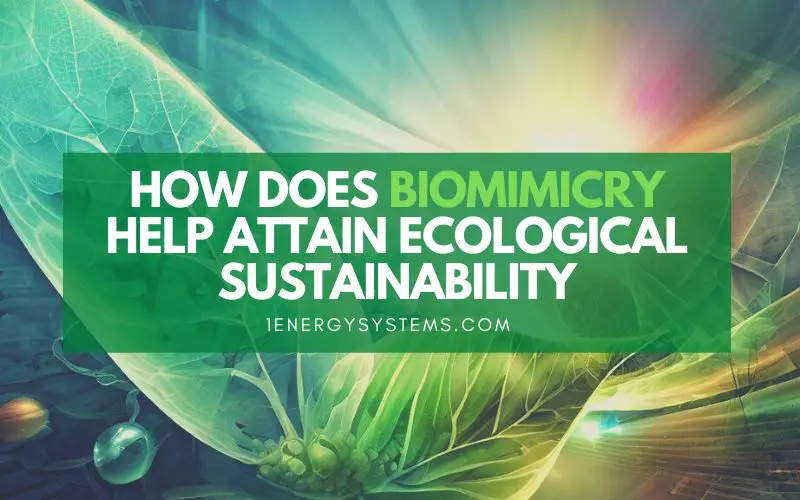As our planet faces unprecedented environmental challenges, finding innovative solutions to achieve ecological sustainability is more important than ever.
Enter biomimicry, a groundbreaking approach that seeks inspiration from nature’s efficient and ingenious methods honed over millions of years.
By mimicking these natural processes, it can transform industries ranging from agriculture to architecture in environmentally friendly ways. In this blog post, we’ll explore the fascinating world of biomimicry and how its principles can help pave the way for a sustainable future.
Understanding Biomimicry And Its Relationship With Ecological Sustainability
Biomimicry involves studying nature’s sustainable strategies to create innovative designs and technologies that can help achieve ecological sustainability.
Biomimicry is an innovative approach to problem-solving that seeks sustainable solutions by drawing inspiration from nature’s time-tested strategies, structures, and processes.
This interdisciplinary concept combines engineering, biology, architecture, and many other fields to pursue eco-friendly design.
For example, one might study how birds can fly efficiently for long distances with minimal energy expenditure.
By observing and analyzing their wing structure and flight patterns, engineers can apply those principles to improve aircraft design more energy-efficiently.
Similarly, examining how plants harness sunlight for photosynthesis could inform the development of advanced solar cells or even improved building energy management systems.
The Advantages Of Biomimicry For Ecological Sustainability
Biomimicry offers a promising path to ecological sustainability by examining nature-inspired designs and harnessing the power of interdisciplinary approaches.
One significant advantage is that biomimicry encourages innovation while prioritizing ecosystem preservation, making it an environmentally responsible solution to existing challenges.
Furthermore, biomimicry promotes function-based technology while taking inspiration from nature’s structures and functions, which often surpass their man-made counterparts in terms of efficiency and resource use.
This translates into reduced consumption of resources such as energy or water in various sectors like agriculture or architecture.
By mimicking natural processes like photosynthesis for solar power generation or designing buildings based on termite mounds for passive cooling techniques, industries can substantially decrease their reliance on non-renewable resources and move toward ecological sustainability.
Examples Of Biomimicry In Achieving Ecological Sustainability
Biomimicry has been successfully implemented in sustainable agriculture, energy efficiency, and architecture – read on to discover how these innovations inspire more ecologically sustainable solutions.
Sustainable Agriculture
Sustainable agriculture is vital to achieving ecological sustainability, as it focuses on eco-friendly farming practices that minimize environmental damage and promote overall conservation.
One example of biomimicry’s application in sustainable farming is utilizing technologies such as drones and sensors to monitor farms more efficiently. This advanced oversight allows for better land management, reducing waste and improving crop yields without putting undue strain on ecosystems.
Additionally, incorporating nature-inspired designs such as closed-loop systems can help diminish resource usage by establishing efficient recycling mechanisms similar to those found in nature.
Moreover, promoting mutualism – wherein different species collaborate for their benefit – further showcases how adopting principles from nature can lead to transformative changes in agricultural practices.
Energy Efficiency
One of the key benefits of biomimicry in achieving ecological sustainability is its potential to improve energy efficiency.
By studying how nature optimizes energy usage, designers and engineers can create more efficient systems and technologies that use fewer resources and emit less pollution.
For example, researchers have used the design principles of termite mounds to develop passive cooling systems for buildings that require no electricity or refrigerants. This approach has shown promise in reducing energy consumption for air conditioning by up to 90%.
Additionally, wind turbines based on humpback whale fins’ shape and motion patterns are 20% more efficient than traditional designs.
Sustainable Architecture
Sustainable architecture is a critical aspect of achieving ecological sustainability. Through biomimicry, nature-inspired design has revolutionized the construction industry.
Buildings can be designed to mimic the natural forms, processes, and ecosystems that have evolved over millions of years to perform specific functions efficiently and sustainably.
This approach can lead to innovative designs incorporating renewable energy sources, waste reduction systems, water conservation strategies, and other sustainable practices to minimize environmental impacts.
For instance, architects are increasingly looking at patterns found in ecosystems such as ant colonies or termite mounds for ideas on creating more efficient building designs.
The biomimetic architecture allows humans to learn from nature’s solutions for achieving sustainability. The principles behind biomimicry offer architects new insights into designing buildings that improve our daily lives while reducing our collective footprint on Earth.
Conclusion
In conclusion, biomimicry offers a groundbreaking opportunity to address our environmental sustainability challenges.
By emulating nature’s designs and strategies, we can develop products and technologies that are sustainable, efficient, and environmentally friendly.
Biomimicry is a problem-solving approach and a philosophy for more responsible living that aligns with our natural ecosystems.
Its potential use in various fields, such as sustainable agriculture, energy efficiency, and architecture, gives hope for creating a better future for all of us.

